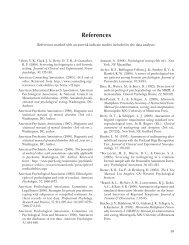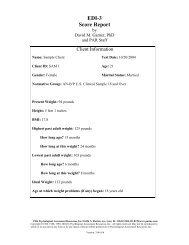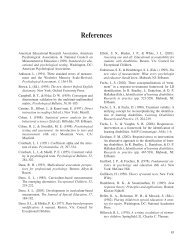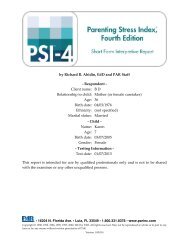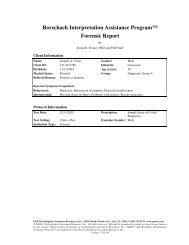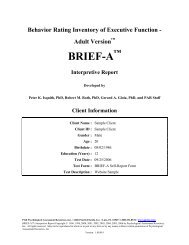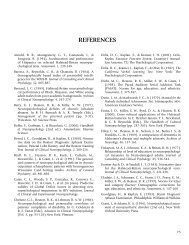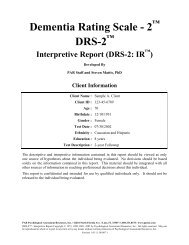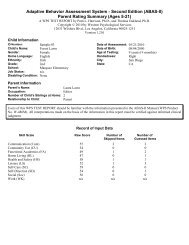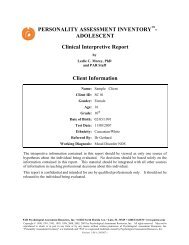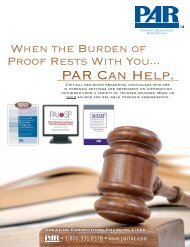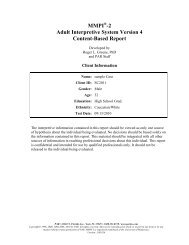MSI-R - Western Psychological Services
MSI-R - Western Psychological Services
MSI-R - Western Psychological Services
You also want an ePaper? Increase the reach of your titles
YUMPU automatically turns print PDFs into web optimized ePapers that Google loves.
Marital Satisfaction Inventory, Revised (<strong>MSI</strong>-R)A WPS TEST REPORT by Douglas K. Snyder, Ph.D. and David Lachar, Ph.D.Copyright ©1997 by <strong>Western</strong> <strong>Psychological</strong> <strong>Services</strong>12031 Wilshire Blvd., Los Angeles, California 90025-1251Version 1.213WifeHusbandAdministration Date: 7/23/97 7/23/97Processing Date: 7/23/97 7/23/97Client ID Number: 00101001 00101002Gender: Female MaleAge: 44 years 45 yearsEducation: 16 years 18 yearsLength of Current Marriage: 23 years 23 yearsNumber of Previous Marriages: 0 0Ethnicity: Not Entered Not EnteredNumber of Children: 3 3Age of Oldest (or Only) Child: 17 years 17 yearsAge of Youngest Child: 11 years 11 yearsEmployed Outside the Home: Yes YesHours Worked per Week: 50 hours 50 hoursPresent Occupation: Bus. Mgr./Lwr. Prof./Teacher Bus. Mgr./Lwr. Prof./TeacherThis interpretive report for the <strong>MSI</strong>-R is an aid for relationship evaluation and treatment planning. The user should befamiliar with the material presented in the <strong>MSI</strong>-R Manual (WPS Product No. W-328B). No evaluation or treatmentdecisions should be made solely on the basis of this report without confirming information from independent sources.<strong>MSI</strong>-R Scales Raw T 30T 40T 50T 60T 70TInconsistency (INC) Wife 4 52Husband 2 42Conventionalization (CNV) Wife 0 34Husband 0 31Global Distress (GDS) Wife 18Husband 206774AffectiveCommunication(AFC) WifeHusband886063Problem-SolvingCommunication(PSC) Wife 13Husband 156164Aggression (AGG) Wife 5 61Husband 6 65Time Together (TTO) WifeHusband675863DisagreementAbout Finances(FIN) WifeHusband776264SexualDissatisfaction(SEX) WifeHusband1186956Role Orientation (ROR) WifeHusband885153Family Historyof Distress(FAM) WifeHusband154255DissatisfactionWith Children(DSC) Wife 6Husband 106677Conflict OverChild Rearing(CCR) WifeHusband786676Interpretive Key(does not apply to ROR Scale)Good Possible Problem Problem Client KeyWifeHusband
WPS <strong>MSI</strong>-R TEST REPORT ID: 00101001, 00101002 Page: 2Test InterpretationResponse Adequacy and ConsistencyBoth partners have described theirrelationship in a consistent manner. They appearto have read each statement carefully inconsidering its meaning as applied to theirrelationship.Global Relationship AffectThese two individuals have described theirrelationship in a highly similar manner. Bothpartners openly acknowledge serious difficultiesin the relationship and dissatisfaction with oneanother; they may have a tendency to emphasizeconflict and to ignore more positive aspects ofthe relationship. Overall, they indicate extensivedistress in the relationship and feelings ofalienation and anger toward one another.Relationship problems are likely to be of longduration and to have spread across differentareas. Individuals with similar scores tend todescribe their relationships as greatlydisappointing; general inability to resolve evenminor differences is characteristic. In response todifficulties in the relationship, both individualsmay have withdrawn emotionally from therelationship and may be reluctant to confide inone another. They describe their relationship ashaving an uncertain future, and may expressstrong reservations regarding the potential forimproving it. Determination of specific stepseither partner has taken toward separation ordivorce would be advisable.Communication and Conflict ManagementBoth partners express dissatisfaction with theamount of affection shown by one another,although the wife reports somewhat less distressin this regard. Individuals with scores similar tothose of the wife often feel emotionally distantfrom their mates, and may feel unappreciated ormisunderstood. They may wish that their mateswould be more open about expressing feelings,and they often describe themselves as beingsomewhat reluctant to confide in their mates.Depending on the amount of relationship distressin other areas, the wife may be motivated topursue ways in which she and her mate canimprove intimacy and mutual self-disclosure.In comparison, the husband describesextensive dissatisfaction with the quality ofaffection expressed in the relationship.Individuals with scores similar to those of thehusband typically describe their mates asemotionally distant and uncaring. The husbandmay describe his mate as withdrawn andunsupportive. Like the wife, the husband is likelyto feel unappreciated and misunderstood, andmay be reluctant to confide in his mate. Thehusband’s experience of emotional distance fromhis mate is likely to limit the couple’seffectiveness in resolving their interpersonaldifferences.Both partners describe extensive difficulties inresolving disagreements. Arguing is likely to befrequent; common patterns of nonconstructivecommunication may include exchange of angryfeelings, failure to acknowledge each other’sview, or attributing each other’s behavior tohostile intentions. There may exist a longaccumulation of unresolved differences, with theresult being that even minor disagreements leadto major arguments. Both partners are likely toperceive each other as being overly sensitive orcritical, with certain areas of the relationshipbeing “off limits” for discussion. Each partner islikely to regard the other as stubbornlyunyielding and unresponsive to legitimateconcerns or complaints.Both partners report extensive concernregarding intimidation and the potential forphysical aggression by one another. Previousincidents involving loss of anger control,throwing, slamming, or destroying objects, orthreats of violence by either partner toward theother are likely. Among individuals with similarscores, many report having been hit or kicked,or having been the target of an object thrown bytheir partners; some report having beenphysically beaten or choked. Careful inquiryshould be made into both the circumstances ofpast aggression and steps taken by both partnersto prevent its recurrence. In addition, bothpartners’ preparedness to leave a situation when
WPS <strong>MSI</strong>-R TEST REPORT ID: 00101001, 00101002 Page: 3confronted with threats of violence should beevaluated.The willingness and ability of each partner toengage in specific anger-management andself-control techniques should be carefullyassessed. Couples beginning therapy should becautioned that therapy often brings to thesurface strong negative feelings attached toprevious events, and that special precautionsmust be taken to ensure that therapy canproceed without concern regarding increasedrisk for aggression.Specific Areas of InteractionOverall, the partners have evaluated specificdimensions of their interaction in a somewhatsimilar manner. This pattern is fairly commonamong couples from the general population,where both partners may experience relativelylittle distress across different areas of theirrelationship. Among couples in counseling, thispattern reflects moderate agreement in partners’views of distress and suggests that they maywork together in rank-ordering relationshipconcerns and identifying initial common goals.Both partners report dissatisfaction with thequality and quantity of leisure time spenttogether, although the wife describes somewhatless distress in this regard. They may have fewcommon interests and may engage in fewactivities together either inside or outside thehome. It is unlikely that the couple’s distress inthis area results entirely from insufficient timefor leisure; rather, they may regard each other asbeing somewhat withdrawn or lacking a desirefor closer involvement in mutual activities. Thehusband’s level of distress in this area likelycontributes to a sense of isolation and distancefrom his mate.Both partners describe finances as an area ofextensive disagreement. Arguments aboutmoney are likely to be common, and the couplemay differ sharply regarding their financialpriorities. Either partner may regard the other asa poor manager of their financial resources, andas either untrusting or untrustworthy.Disagreements are likely to extend beyond theadequacy of income to include complaints aboutthe partner’s selfishness, irresponsibility, or lackof mutual commitment toward resolving thecouple’s financial difficulties.Both individuals indicate dissatisfaction withtheir sexual relationship, although the husbandreports somewhat less distress in this area.Disagreements regarding the frequency orvariety of sexual behaviors may be frequent; it issomewhat unlikely that sexual difficulties ariseentirely from more general distress, and specificinterventions in this area may be warranted.Both partners may describe one another asuncaring or uncommitted to a satisfying sexualrelationship, and may complain of dissatisfactionwith nonsexual expressions of affection. Thecouple is likely to have difficulty in discussingsexual matters openly and effectively.Concerns Regarding ChildrenThe partners both describe extensive distressin interactions with each other regarding theirchildren. Conflicts around division of child careresponsibilities are common, and the partners arelikely to experience significant disagreementsregarding discipline and their children’sprivileges and responsibilities. The couple couldlikely benefit from interventions aimed atclarifying their respective expectations for theirchildren’s behavior and identifying eachpartner’s responsibilities for various child rearingtasks.Both individuals describe extensive distress intheir own relationships with their children. Theyare likely to report disappointment with thechildren’s behavior or dissatisfaction with thegeneral demands of child rearing. They mayregard themselves as ineffective parents, andmay experience a lack of closeness to theirchildren. One of the children may be describedas having emotional or behavioral problems, andany distress in the relationship may be viewed asarising in part from child rearing difficulties. Acareful assessment should be conducted todetermine the extent to which the partners sharesimilar views of their children; furtherassessment or counseling for the children may beindicated.Role Orientation and Family History
WPS <strong>MSI</strong>-R TEST REPORT ID: 00101001, 00101002 Page: 4Both partners describe themselves as havingfairly moderate views toward household andparental roles, supporting neither highlytraditional nor highly nontraditional orientations.Individuals who give similar responses generallybelieve that both partners ought to have equalinfluence in decisions regarding family matters.They may prefer a more flexible division ofhousekeeping and child rearing tasks, with bothpartners pursuing independent careers andsharing equally in housework and child careresponsibilities. The couple’s responses in thisregard express their role values, and the extentto which these preferences are consistent withtheir actual role behaviors in the relationshipshould be carefully evaluated.Finally, the partners differ somewhat in theirdescriptions of their relationships within thefamilies in which they grew up. The wifedescribes a fairly happy childhood and positivefeelings toward her siblings and parents. Shedescribes her parents’ relationship as beingrelatively free of distress. In comparison, thehusband describes significant disruption in hisrelationships with other members of his family.His parents’ relationship may have beencharacterized by difficulties in expressingaffection or resolving differences.Nonconstructive ways of interacting in thehusband’s family of origin should be carefullyexamined to determine the extent to which theyhave led to similar problems in the couple’s ownrelationship.
WPS <strong>MSI</strong>-R TEST REPORT ID: 00101001, 00101002 Page: 5Listing of ResponsesWife’s Responses1. F 26. T 51. T 76. F 101. T 126. F2. F 27. T 52. T 77. T 102. F 127. F3. F 28. F 53. T 78. T 103. T 128. F4. T 29. F 54. T 79. F 104. F 129. T5. T 30. F 55. F 80. T 105. T 130. F6. F 31. F 56. F 81. F 106. F 131. F7. F 32. F 57. T 82. T 107. T 132. T8. T 33. T 58. T 83. T 108. F 133. F9. T 34. F 59. T 84. F 109. F 134. F10. F 35. T 60. T 85. F 110. F 135. F11. T 36. T 61. F 86. F 111. T 136. T12. T 37. T 62. T 87. F 112. T 137. T13. T 38. T 63. T 88. F 113. F 138. F14. F 39. F 64. F 89. F 114. T 139. T15. T 40. T 65. T 90. T 115. T 140. T16. F 41. T 66. F 91. T 116. T 141. T17. F 42. T 67. F 92. T 117. T 142. F18. F 43. T 68. F 93. F 118. T 143. T19. F 44. T 69. F 94. F 119. T 144. F20. T 45. F 70. T 95. T 120. T 145. F21. F 46. T 71. F 96. F 121. T 146. F22. F 47. T 72. F 97. F 122. F 147. T23. F 48. T 73. F 98. F 123. F 148. T24. T 49. T 74. T 99. F 124. F 149. F25. T 50. F 75. T 100. T 125. F 150. FNotes: There were 0 missing or double-marked responses on the first 129 questions and0 missing or double-marked responses on the last 21 (child-related) questions.Husband’s Responses1. F 26. T 51. F 76. F 101. T 126. F2. F 27. T 52. F 77. T 102. F 127. F3. F 28. T 53. T 78. T 103. F 128. F4. F 29. T 54. T 79. F 104. F 129. F5. F 30. F 55. F 80. F 105. T 130. F6. T 31. F 56. F 81. F 106. F 131. F7. T 32. F 57. T 82. F 107. T 132. T8. T 33. T 58. T 83. T 108. F 133. T9. T 34. F 59. T 84. F 109. F 134. T10. F 35. F 60. T 85. F 110. F 135. F11. T 36. T 61. F 86. F 111. F 136. T12. F 37. T 62. T 87. F 112. T 137. T13. T 38. T 63. T 88. F 113. F 138. T14. F 39. F 64. F 89. F 114. F 139. T15. T 40. F 65. F 90. T 115. T 140. T16. F 41. T 66. F 91. T 116. F 141. T17. T 42. T 67. F 92. T 117. T 142. T18. T 43. F 68. T 93. T 118. T 143. F19. T 44. T 69. F 94. F 119. F 144. T20. T 45. F 70. T 95. T 120. F 145. F21. F 46. T 71. T 96. F 121. T 146. F22. T 47. F 72. F 97. T 122. F 147. F23. F 48. F 73. T 98. T 123. T 148. T24. F 49. T 74. F 99. F 124. T 149. F25. T 50. T 75. F 100. T 125. T 150. FNotes: There were 0 missing or double-marked responses on the first 129 questions and0 missing or double-marked responses on the last 21 (child-related) questions.Key to responses: T = true, F = false, - = missing.This report was generated based on WPS TEST REPORT Microcomputer Data Entry.END OF REPORT



